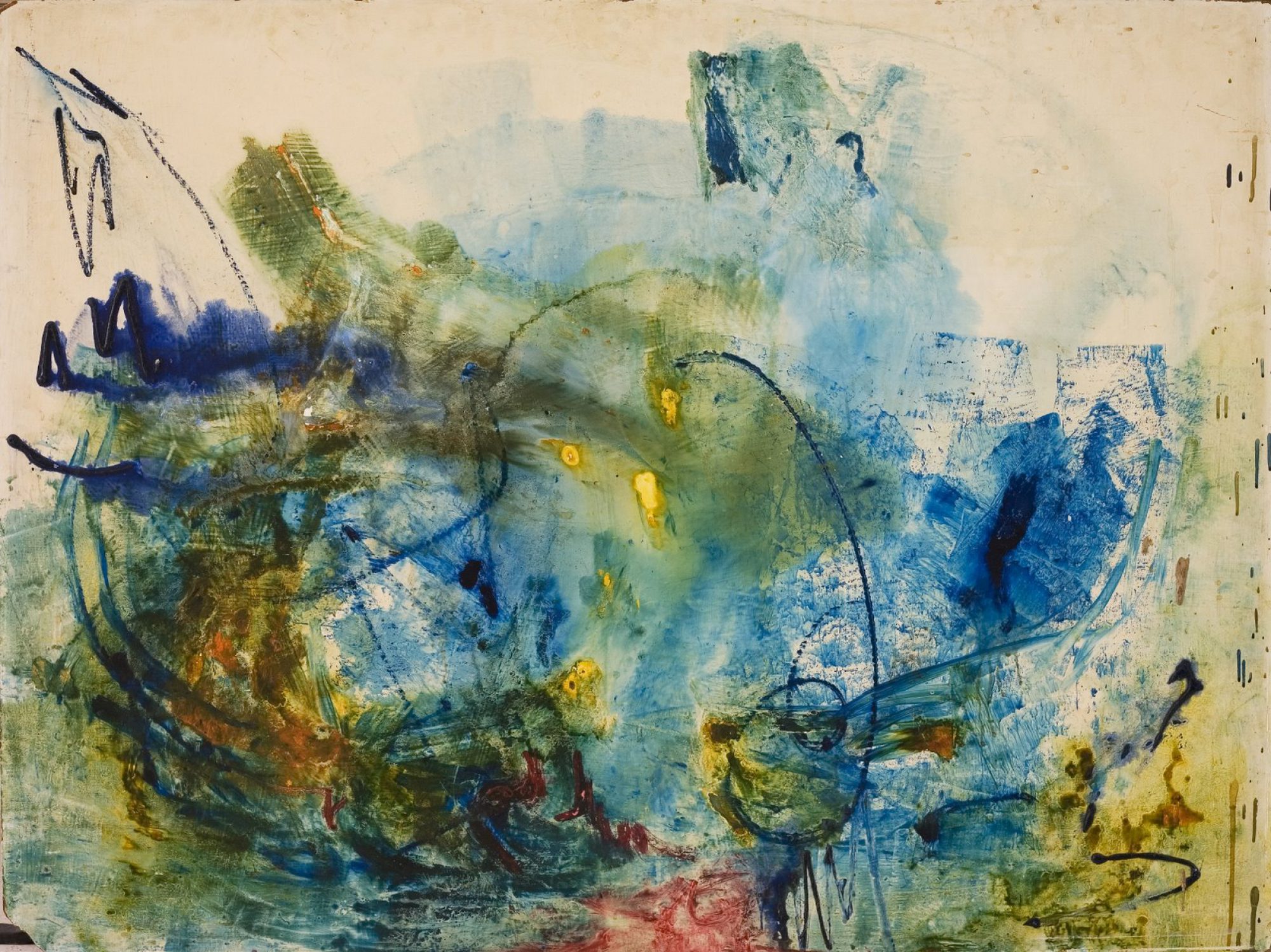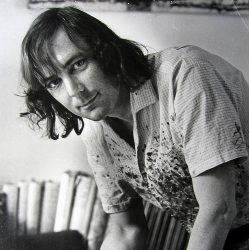“Call me Back: Celebrating the Life of Marshall Baron 1934 – 1977”
About the exhibition on National Gallery of Zimbabwe in Bulawayo Facebook page
Currently Showing: Marshall Baron Gallery
Tribute to Marshall Baron Celebrating the life of Marshall Baron 1934 – 1977
From its Permanent Collection, the National Gallery of Zimbabwe presents Call me Back: Celebrating the life of Marshall Baron 1934-1977.
This is an exhibition of paintings that celebrate the life and achievements of one of the most important masters of abstract visual arts in Zimbabwe, Marshall Baron. This man was not just an artist but also a man of wide ranging talents and interests. Baron was known as an artist, music critic, lawyer and a humanist. Today Baron remains one of the most important masters of abstract visual arts in this country even more after his death in 1977. The work of Marshall Baron goes beyond any historical categorization. His own peculiar humour was an important factor in the spirited way he tackled the unwritten rules of painting.
Marshall Baron was born in Bulawayo on the 3rd of August 1934, where he spent his entire life and loved the town and its people. Besides being a lawyer, music critic and political activist, Marshall Baron was a serious prolific painter whose works possess a strong expressionist value. He was very active and influential in the local art world and was a committee member of the Rhodesian Society of Artist. Marshall worked tirelessly in bridging the gap between the white and black artists. His works display a strong feeling of colour, texture and tonal ranges and has an organic rather than a geometric feeling. The works in this exhibition express themselves with intense directedness through their colour.
Marshal Baron was largely a self-taught artist who travelled extensively and was well acquainted with the current trends in visual art. His abstracts according to Marion Arnold “inject a provocative and experimental note. His work is misunderstood by the public but it is held in high esteem by those knowledgeable about contemporary art. It is the input of his personality and intellect, knowledge of literature and mythology that makes his work unique”.
Baron’s key element in his development as an artist was his exposure to Abstract Expressionism in 1966-68 when he attended three consecutive Summer Schools at Skowhegan Maine. Commenting on his experience there, Baron said it “reinforced my feeling that abstractionism is for me, I find it infinitely challenging to make the paint work out its own statements without falling back on imagery.”
This show traces and celebrates Marshall Baron’s life and his contribution to the development of visual arts in Zimbabwe. He will be remembered as the father of Abstract Expressionism in this country. His spirit continues calling and many exhibitions of his works have happened around the world since his death. The title Call me back is taken from one of his works in this exhibition and it reflects how his spirit remains in many people’s minds, hearts and homes.
Tribute to Marshall Baron – 1935 – 1977 by Voti Thebe (Regional Director of the National Gallery of Zimbabwe)
Marshall was a prolific painter. He painted on large canvases and was very influential in visual arts during the 70s. He worked tirelessly in bridging the gap between the white and black artists. He was pivotal in the abstraction expression.
I was introduced to Marshall by Steve Williams during one of the Rhodesian Society of Artists’ meeting at the society’s gallery in Grand Hotel building now Bulawayo Centre.It was a time of reckoning; we used to have jazz jam sessions, poetry readings, exhibitions and coffee.
I remember when the gallery moved to the old market place on Grey Street (now Robert Mugabe Way) and Selborne Avenue (now Leopold Takawira Avenue).It became every artist’s meeting place, there was always an urn of hot water for coffees and teas and it became a joint for artists.You would bring your sandwiches to share with other artist.
One time at the opening of one of the annual exhibitions. We had received one of Marshall’s abstract paintings on canvas from the framers and we hung it according to the screw eyes that were fixed by the framers. Only to be told by Marshall that the work was upside down. We had to take it down and re-fix the screw eyes according to the artist – Marshall. It was embarrassing in front of the invited guests but we got a lecture from Marshall.He taught us to follow the paint’s drip on the canvas to determine the side up of his work.
Marshall was a pillar in creativity hence I did a painting in memory of him and it was exhibited in one of the exhibition (newspaper cutting attached).His work still lives on today.
“THE ALEMBIC GURU”
MARSHALL BARON
1935-1977 – by RASHID JOGEE (ARTIST)
Marshall Baron, artist, musician, politician, philosopher and defender of the oppressed.
“The Alembic Guru” – Marshall Baron emerged as a dynamic and prolific abstract, expressionist painter in the early 60s in Bulawayo. As a lawyer and a legal practitioner he was keenly aware of the unjust practices of the Rhodesian government and defended the discriminated. Ben Baron and partners, Marshall’s family of legal practitioners acted as defence counsel to Joshua Nkomo and the “national democratic party”. Marshall as a young man became a formidable opponent of the white supremacy regime of Ian Smith and the ruling party, the Rhodesian front. Marshall Baron was known for his very large paintings, angered and wild outpouring of acrylic paint on very large canvases. His works immediately began to shock, irritate and anger the very conservative white society.
His works relentlessly questioned the value system of the Rhodesian culture. Furthermore Marshall was greatly influenced by modern movements in American abstract painting (The “New York School”) and the protest paintings of the angry young men of America.
He enjoyed many strong relations with American contemporary artists and art critics and was responsible for bringing the famous art critic Clemence Greenberg to Bulawayo. Marshall often travelled to America to work study and confer with contemporary American artists, only to return to Bulawayo to report on recent movements in America. I first became aware of Marshall Baron and his work as a public figure and intellectual as he often visited our school, Founders High School as a guest of honour at school assemblies and talk to our sixth form forum.
Founders High School at that time was a racially segregated school for Coloureds and Asians, also a discriminated community. Marshal encouraged us to subvert the present racially segregated state. He of course was a brilliant lawyer and therefore a defender of justice. Marshall with his multi-faceted talents inspired us all and he soon became the jewel of the intelligible intellectual societies who remained opposed to the unjust white supremacy regime of the day.
The sage and the guru of the rebellious youth in every way he symbolised and epitomised the revolutionary spirit in the age of protest. I being 15 years younger became acquainted with Marshall through another young white painter Stephen Williams. Stephen and Marshal who shared the same political ideas worked together as a team producing exhibitions at that time at the only art gallery in Bulawayo “Naakes Private Gallery”. These exhibitions also served to anger and shock the conservative white ‘die hards’ as they attracted multi-racial audiences and advocates of multi-racism.
In my very own opinion it would be very difficult for a man of such talents and intense sensitivities to survive the restricted repressive unrealistic state that Ian Smith and the Rhodesia front had created. Civilians at all levels were being conscripted to fight what was the inevitable and that was majority rule. In 1977 at the height and heat of the war for independence I, like many other civilians who were conscripted (in the medical corps) in the most remote southern border of Rhodesia had heard by post that Marshall had tragically died.
Marshall died in the May of 1977 and he was only 42 years of age. In his very short life he had achieved much and created a very large volume of works which still survive for us to appreciate and still serve to inspire us all. “Flowers do not live for long, they blossom a while then fade and die”. Sadly to be missed I often wonder why? And what would his attitude be of the present day politics and what would his canvases say.
Cliford Zulu, Curator

